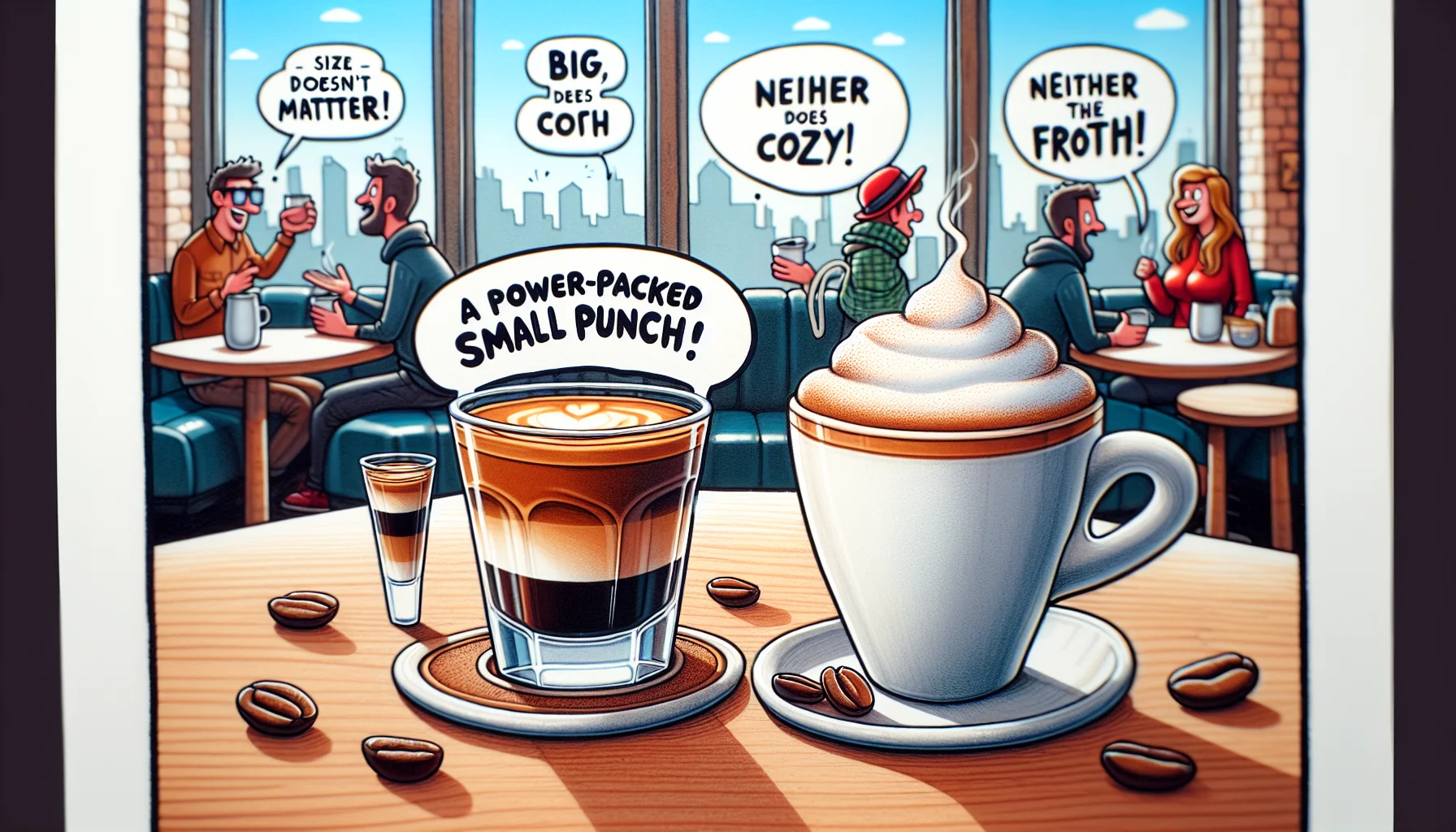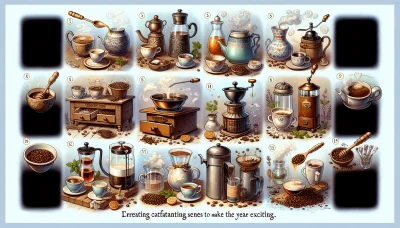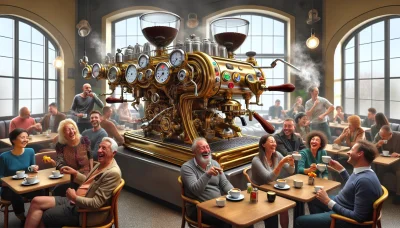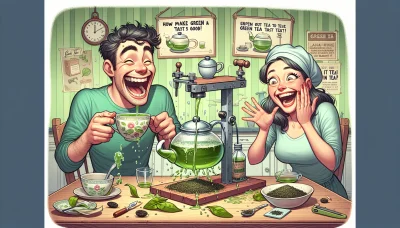Cortado vs cappuccino Quiz
Test Your Knowledge
Question of
Cortado vs Cappuccino: Understanding the Difference
When exploring the world of espresso-based drinks, it's easy to get overwhelmed by the variety of options available. Two popular choices among coffee aficionados are the cortado and the cappuccino. While both beverages start with a base of espresso, the primary difference lies in their milk content and texture. A cortado is made with an equal ratio of espresso to steamed milk, aiming to reduce the acidity of the espresso without overshadowing its strong coffee flavor. On the other hand, a cappuccino consists of three layers: a shot of espresso, a similar amount of hot milk, and a layer of frothy, steamed milk on top, creating a creamy texture with a more diluted coffee taste compared to a cortado. Understanding these differences can help coffee lovers make a more informed choice according to their preference for milk and coffee balance.
What is a Cortado?
A cortado is a type of coffee drink that originated in Spain. It is made by combining equal parts of espresso and steamed milk to reduce the acidity, resulting in a smooth and strong coffee flavor. The word "cortado" means "cut" in Spanish, referring to the milk cutting through the espresso. Unlike larger milk-based coffee drinks, the cortado offers a balance that highlights the espresso's bold flavors without overwhelming them with too much milk. Its taste is characterized by a rich, creamy texture and a balanced acidity, making it a popular choice for those who appreciate the strength of espresso but prefer a slightly milder and silkier drinking experience.
What is a Cappuccino?
A cappuccino is a popular coffee drink that originated in Italy, known for its rich flavor and smooth texture. It is traditionally made with equal parts of espresso, steamed milk, and milk foam, which gives it a creamy and airy consistency. The espresso provides a robust base, the steamed milk adds sweetness and body, and the milk foam offers a light and velvety finish. The cappuccino is celebrated for its balance of flavors and textures, making it a favorite among coffee enthusiasts around the world. Its taste can vary depending on the quality of the coffee beans used, but it generally has a bold, rich, and slightly sweet profile that is enhanced by the creamy milk.
Key Differences Between Cortado and Cappuccino
- Milk to Coffee Ratio: A cortado has an equal ratio of espresso to milk, while a cappuccino typically has a one-third espresso, one-third steamed milk, and one-third milk foam ratio.
- Texture: Cappuccinos have a frothy and airy texture due to the milk foam, whereas cortados have a smoother and silkier texture.
- Serving Size: Cortados are usually served in smaller glasses, making them smaller in size compared to cappuccinos, which are served in larger cups.
- Milk Foam: Cappuccinos are known for their thick layer of milk foam on top, while cortados have little to no foam, focusing on the harmony between milk and espresso.
- Flavor Intensity: Due to the higher ratio of coffee to milk, cortados have a more intense coffee flavor than cappuccinos, which are milder due to the added milk and foam.
How to Make a Cortado
To make a cortado at home, start by brewing a strong, espresso-like coffee. If you have an espresso machine, pull a double shot of espresso. Meanwhile, heat up an equal amount of milk, aiming for a temperature that's hot but not scalding. Froth the milk lightly to create a small amount of microfoam. Pour the hot milk and foam over your espresso, aiming for a 1:1 ratio of coffee to milk. The goal is a harmonious balance between the rich coffee and the creamy milk. Serve immediately and enjoy your homemade cortado.
How to Make a Cappuccino
Making a cappuccino at home is a delightful way to start your day, and it's easier than you might think. First, start by grinding fresh coffee beans to a fine consistency. You'll need about 18 grams of coffee for a standard cappuccino. Next, brew a strong shot of espresso using an espresso machine or a stovetop espresso maker. While your espresso is brewing, pour about 4 ounces of milk into a steaming pitcher. Use the steam wand on your espresso machine to steam the milk until it's frothy and has doubled in volume. Once your espresso is ready, pour it into a large cup. Finally, gently pour the steamed milk over the espresso, holding back the foam with a spoon until the cup is almost full, then spoon the foam on top. For an extra touch, you can sprinkle a bit of cocoa powder or cinnamon on top of the foam. Enjoy your homemade cappuccino!
Cortado vs Cappuccino: Which has more caffeine?
When comparing cortado and cappuccino, it's important to understand that the caffeine content primarily depends on the amount of espresso each drink contains rather than the milk or foam added. Both drinks traditionally start with a shot of espresso, which means their caffeine content is quite similar if the espresso shot volume is the same for both. However, variations can occur based on how the espresso is prepared or if additional shots are added to either drink. In general, if both are made with a single shot of espresso, a cortado and a cappuccino will have roughly the same amount of caffeine. The difference in taste and texture comes from the milk ratio and preparation, not the caffeine content.
Cortado vs Cappuccino: Nutritional Comparison
| Nutrient | Cortado (8 oz) | Cappuccino (8 oz) |
|---|---|---|
| Calories | 60 | 80 |
| Fat (g) | 3 | 4 |
| Protein (g) | 4 | 4 |
| Carbohydrates (g) | 5 | 5 |
| Sugar (g) | 4 | 6 |
| Caffeine (mg) | 65 | 65 |
Conclusion: Choosing Between a Cortado and a Cappuccino
After delving into the nuances of both cortados and cappuccinos, it's clear that each coffee has its unique appeal. A cortado, with its equal parts espresso and steamed milk, offers a stronger coffee flavor that is perfect for those who appreciate a robust espresso but desire a smoother finish. On the other hand, a cappuccino, with its distinct layers of espresso, steamed milk, and frothy milk, presents a more textured and airy experience, ideal for individuals who enjoy a creamier, lighter coffee. Ultimately, the choice between a cortado and a cappuccino boils down to personal preference. Those who favor a bold coffee taste with a hint of creaminess might lean towards a cortado, while those who prefer their coffee to be lighter and frothier might find a cappuccino more to their liking.












